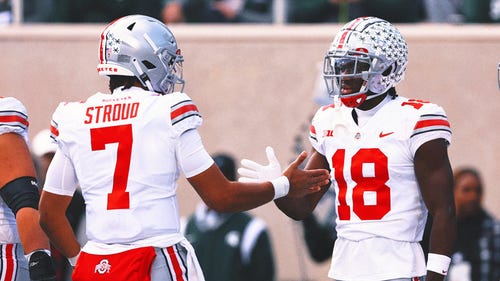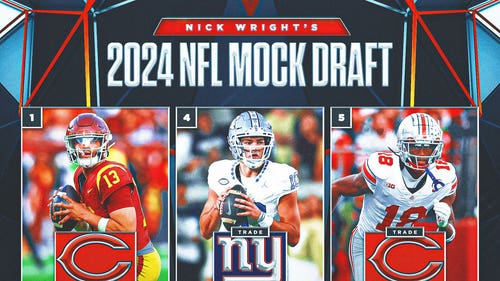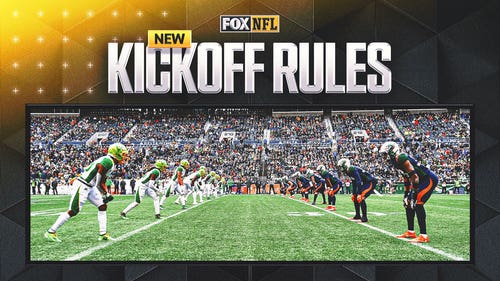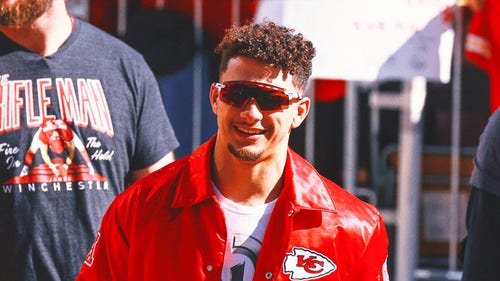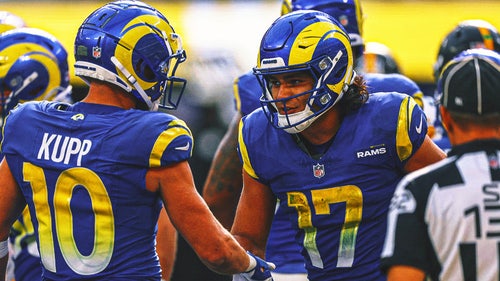
Inside the film room with top NFL QB prospect Mitchell Trubisky
There are people who wonder aloud whether you can make throws into tight windows. What do you say to them?
“Watch the film,” Mitchell Trubisky tells me.
We’re viewing a projector screen in North Carolina’s offensive line room, sitting in leather recliners donated by former Tar Heels lineman Jonathan Cooper, a first-round pick in the 2013 NFL draft. The five recliners are reserved for starting offensive linemen, but none is here today. It’s spring break at UNC. Trubisky, projected to be a first-round pick, is in Chapel Hill for meetings with NFL teams and his pro day workout, which is four days away.
Right now he’s analyzing the final game of his college career: a 25-23, nail-biting loss to Stanford in the Sun Bowl.
“There’s a lot of critics out there,” he continues, “but I think I’ve been able to show I can make a lot of the tight-window throws. I’m confident in what I’m able to do.”
On a 1-10 scale, 1 being Joe Schmoe and 10 being Aaron Rodgers, where would you put your arm strength? “Probably like a 9 . . . 8 or a 9?” Trubisky says.
Outside opinions vary in this department, but on the Stanford film, it’s indisputable that Trubisky’s arm is NFL-caliber. He made several throws to the far sideline, mostly on comeback patterns, which were a staple of North Carolina’s offense last season.
Often, arm strength is best exhibited on throws that a quarterback makes from a muddied pocket, where he doesn’t have room to step into the throw. Muddied pockets are common in pro football, and one concern about Trubisky is that he has little experience navigating them (he started only 13 games in Carolina’s quick-paced shotgun offense). But every time he encountered bodies around him against Stanford, he moved with subtly and poise while keeping his eyes downfield. That’s a positive indicator for growth potential, and not one you see often from players with Trubisky’s higher-level mobility.
Some of Trubisky’s best plays came when he was outside the pocket, throwing while improvising on the move. The one that stands out against Stanford was on a third-and-8 early in the second quarter.
“So we got a 3-by-1 stack,” Trubisky explains, gesturing toward the staggered three-receiver grouping at the bottom of the screen. “The reason we stacked the receivers is so [Stanford] couldn’t press [shifty but undersized receiver Ryan Switzer]. That’ll help him get an easier release [off the line of scrimmage].” The concept prohibits the defensive backs from being able to jam Switzer.
“Switz is my first read and then I got this backside dig route as my second read,” Trubisky continues, pointing out the lone receiver on the top of the screen. “And the check-down is my third read. Basically I’m just working through my progressions, keeping my eyes down field, stepping up in the pocket, feeling the rush.”

No one got open and the check-down man was tied up in a blocking assignment, making him late to leave the backfield. “At this point, I know I have to scramble,” Trubisky says. “And then my dig turns into a ‘big over’ route.” Moving to his right, outside the pocket, Trubisky threw a frozen rope to Jordan Cunningham, who continued running horizontally across the field, for a gain of 13.
“I just found a completion and picked up a first down,” Trubisky says.
Tremendous play, but one rendered moot three snaps later when Trubisky threw the first of two interceptions, both the result of bad quarterbacking.
“I just lock onto Switz too long and the backside safety is reading my eyes,” he says as the screen shows Stanford’s Dallas Lloyd catching the easy pick and running it back 45 yards. “He makes a good play. It’s tough to see as a quarterback, but you just got to be careful with your eyes. I would have liked to have seen that guy in my peripheral.”
Two series later, Trubisky had another turnover, though it’s hard to blame him on this one. He ran up the middle and the umpire’s hand inadvertently knocked the ball out. Asked facetiously if the umpire was a factor here, Trubisky says, “I mean, he’s the only factor. I was wondering why he was in my way; I didn’t know if that was interference and then we’d be able to keep the ball? I didn’t know if that was a rule or not. But I guess he’s part of the field. It’s just bad luck. I make the defender miss, so it’s not like the defender caused the fumble; the ref was clearly in the way.” Told that the umpire will be standing behind the line of scrimmage in the NFL, Trubisky shrugs as if to say, Good to know.
All of these plays occurred out of shotgun. Even though that’s the formation of choice on about 60 percent of NFL snaps these days, much has been made about Trubisky’s having to learn from scratch how to play under center. NFL coaches have been asking him how he’s going to make that adjustment. “I just tell them I’ve been working on it since January,” Trubisky says. “It’s been going great. If anything, it’s helped my footwork. It’s something I feel really comfortable with. I don’t have any film to prove it, I’m just going to have to continue to show teams that I can do it — and I’m confident I will.”
The next series brought about the first of five deep fades that Trubisky threw to 6'5" receiver Bug Howard. It was a game of tremendous highs and lows for Howard. On the low side, the first four of those deep fades fell incomplete. One issue: the play designs called for Howard to release outside coming off the line of scrimmage, but he was repeatedly forced inside by cornerback Quenton Meeks. That was the difference between Howard getting to his landmark and not.
Explaining how to proceed when a receiver is off his spot, Trubisky says, “You don’t want to adjust your throw too much because then you’re risking throwing an interception to the safeties. I’d much rather this throw be an incompletion than have my receiver get killed by the safety.”
With 1:08 left in regulation and the Tar Heels down by eight, Trubisky and Howard finally connected on a deep shot. Interestingly, Howard was again off his landmark, having run his route too close to the sideline and leaving his quarterback minimal space to place the ball. Trubisky still managed put it on him, and Howard won on the jump.
“I have a lot of confidence in Bug,” Trubisky says. By this point in the game, “It’s strange that we hadn’t come down with a downfield vertical ball, so in my head the percentages are that much higher we’re hitting it on this drive.” A wry smile sneaks out as he says this.
The Tar Heels were playing from behind in large part because of Trubisky’s ugly pick-six early in the fourth quarter. On that play, he threw much too late to running back T.J. Logan, who was flaring out of the backfield. The safety Lloyd (again) jumped it, this time so easily that Trubisky, to no avail, turned to run and make the tackle before the ball was even caught.

“They’re playing robber defense,” Trubisky says as the play rewinds. “Bringing a linebacker in and then dropping off the D-end into the field. It's a bad, forced throw. I’m trying to do too much, trying to create a play and it goes the other way. A bad, forced decision.”
What do you say to your teammates after that?
“I own my mistake. ‘This was my bad, it’s not going to happen again. Just stick with the plan, everybody do their job.’ Even with that pick-six we were still not out of the game. After it happens there’s nothing you can do about it. Everyone just kept the faith, kept breathing and we kept battling.”
Indeed, North Carolina’s final drive was spectacular. It began on the Tar Heels’ own 3-yard line and ended, heartbreakingly, with a failed two-point conversion that would have tied the game with 25 seconds remaining. On the drive, Trubisky exhibited many of the traits that have turned him into likely the first QB to come off the draft board.
The key play was that deep jumpball to Howard. On the ensuing snap, Trubisky, with the Tar Heels now on Stanford’s 28-yard-line and just over a minute to go, airmailed a beautiful seam pass to Switzer. Linebacker Jordan Perez, playing Tampa 2, ran down the middle hole and broke it up. Upon release, Trubisky also was hit with both of his heels in the air. He was driven into the ground by Peter Kalambayi. Good football all around.
“Ideally you’d like [Switzer] to stem his route at that Mike ’backer so that I can throw it away,” Trubisky says. (What he means is if the receiver had run toward the middle linebacker, he could have essentially posted him up, creating a window for Trubisky to target on the back shoulder, away from that defender.) Trubisky also had to read the coverage, as did the receiver. If the outside linebacker had stayed over the top of the receiver, then the seam route would have been converted to a hook route.
On the next play, Howard got open and dropped a gimme touchdown on a ball that Trubisky had lofted with perfect placement. (Again: a game of incredible highs and lows for Howard.) All you can do is “laugh it off,” Trubisky says.
After that, Carolina went back to the seam route, only this time out of a trips formation. Stanford played man-to-man instead of Tampa 2. The coverage demanded a precise throw, and Trubisky responded, putting Carolina down at the 1-yard line with just more than 40 seconds remaining. The Tar Heels scored three snaps later, on a rollout that Trubisky extended by turning back across the field. He found Howard for the score. They went to a roll-out again on the two-point conversion, but a protection breakdown allowed for immediate penetration by Stanford’s dominant defensive lineman, Solomon Thomas, a projected high first-round pick. Trubisky wouldn’t know this until a week later, but this was his last play as a Tar Heel.
The film done, Trubisky talks about his pre-draft experiences. His media commitments are growing, individual workouts with teams are upcoming and he’s excited about things he’s learned from visiting with NFL coaches. (“For example, I was talking to Alex Van Pelt, the Packers quarterbacks coach, about what drills Aaron Rodgers practices. They do a lot of simulated throwing on the run.”)
There’s just one thing left to discuss: How many times a day does he hear from friends and fans about the switch from Mitch to Mitchell? “Way more than I need to or want to,” he says with an unsuppressed smile. “People think I was trying to change my name. I don’t really care if it’s Mitch or Mitchell. I was saying my mom prefers Mitchell. People can call me whatever they want.”
Question or comment? Email us at talkback@themmqb.com.
This article originally appeared on








































































































































